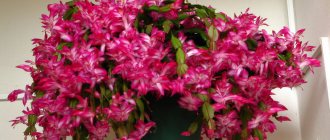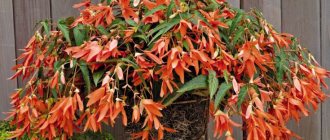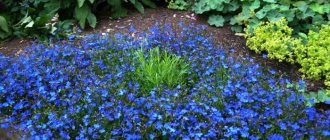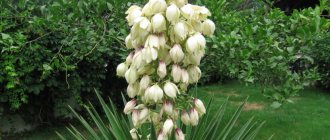A plant such as begonia belongs to the most famous and numerous genus of the begonia family. This genus unites approximately 1 thousand species of various plants, which in natural conditions can be found in the mountains, and they prefer to grow at an altitude of 3–4 thousand meters above sea level; they are also common in tropical rainforests and subtropics. These plants are also found in the mountains of India, the Malay Archipelago, the Himalayas, Sri Lanka and western Africa. There is an opinion that begonia comes from Africa, and then this plant came to America and Asia. Today, more than 1/3 of all species of this plant grow in Africa.
In the 17th century, the monk Charles Plumier found begonia and wrote a description of it. This happened during an expedition to the Antilles, the purpose of which was to collect plants. He discovered 6 different species of such a plant, which he named in honor of M. Begon, who was the governor of Fr. Haiti, with whom the monk was friends. Today, this plant is very popular and is cultivated both indoors and in the garden. Below we will talk about indoor begonia and how to plant it correctly, how to care for it, how it can be propagated and a lot of other interesting and useful information.
Lighting
Decorative begonias love sunlight and will delight you with their picturesque colors when you place them on a south-facing window.
It is advisable to grow flowering begonias at home on windows in eastern and western directions.
Begonias love freedom and even illumination; when placing them next to other plants, leave space between them. Make sure that neighbors do not shade the flower, otherwise it will suffer.
In autumn-winter, compensate for the lack of lighting with special lamps.
Watering
Begonia is a plant with increased air humidity requirements. Information on how to water a flower will not be superfluous for plant connoisseurs.
To water the flower, use settled water at room temperature. Make sure that the water does not stagnate in the pot, otherwise the roots may rot.
Decorative deciduous varieties with fibrous roots should be watered abundantly during the period of active growth.
Tuberous varieties require moderate watering. It is necessary to re-moisten the soil only after the soil in the pot is half dry.
If begonia grows in a room with dry air, then its tips will begin to dry out over time, and the beautiful flowers will dry out. Correct the situation immediately. Install an air humidifier next to the flowers or purchase a tray with a grate under which wet expanded clay will be placed.
Place the pots with begonias on the grid, and the moisture evaporated from the expanded clay will allow the begonias to grow in comfortable conditions.
Humidity
A very significant requirement for growing a tropical beauty is good air and soil humidity.
Attention: it is not permissible to spray the crown with a spray bottle from above - this causes brown spots to appear on the leaves.
To achieve a certain humidity, there are some tricks with the tray. You can pour a layer of expanded clay into it and fill it halfway with water, or you can use hydrogel, but the main thing is that the bottom of the pot itself is not in water. Then the moisture that is so important in a dry room will come from below directly around the flower.
Top dressing
The domestic Begonia plant loves fertilizers and will thank you with abundant and bright flowering. It is recommended from mid-spring to mid-autumn to water the plants once every two weeks with a mineral-vitamin complex for flowering plants.
In specialized stores you can choose a suitable complex for your plants. For flowering species, choose phosphorus-potassium fertilizers; for decorative deciduous species, fertilizers with a high nitrogen content are suitable.
From November to March, flower fertilization should be stopped and begonias should not be prevented from resting before the next blooming year.
Pest and disease control
The set of typical begonia problems is standard for deciduous flowering plants.
— Excess moisture causes fungal diseases and powdery mildew. Check the core of the bush, usually the problem starts there. For treatment, remove all damaged fragments, reduce watering and treat the flower with antifungal drugs;
— The most common parasites are aphids and spider mites. To combat them, use classic insecticides;
Photo: outlawgarden.blogspot.com
— If the begonia does not bloom or the buds fall off, it is most likely cold, windy or lacking light. Try to change the place and not be overzealous with feeding;
— Yellowing leaves mean that the begonia does not have enough moisture or fertilizer. Sometimes this is a symptom of pests that are destroying the roots. Then you need to clean the rhizome, disinfect it with potassium permanganate and transplant the flower into new soil.
Photo: sup-kartoshka.ru
The soil
To plant begonias, choose loose soil with a slightly acidic or neutral environment. In flower shops there are special soils for Begoniaceae.
If you prefer to prepare the soil for plants yourself, then stick to this composition:
- 3 parts leaf soil.
- 1 part peat.
- 1 part humus.
- 1 part coarse sand.
Before planting, it is recommended to disinfect the soil, both purchased and independently prepared - freeze, steam, spill with a solution of hot potassium permanganate or a solution of phytosporin.
Flower container
The optimal container for the plant is wide and low. The diameter of the pot should be no more than 4 cm larger than the root system of the begonia. If you choose a larger pot, you risk that the plant will bloom later.
The material from which the flowerpot is made also matters. The best solution for begonias is a ceramic pot.
Features of care in winter
In winter, most plants go into a dormant period. Watering is reduced.
The amount of light decreases in winter, so begonia is placed closer to the window or artificial lighting is added.
Protect the plant from exposure to cold air and radiators. Carefully monitor the watering regime, its excess will lead to rotting of the root system.
Also read on our website about the following varieties of begonia: Red-leaved, Bauer, Masona, Hogweed, Cleopatra, Royal, Spotted, Vorotnichkovaya.
Landing
Fill the prepared flowerpot one third with expanded clay; to prevent fungal diseases, add a small layer of charcoal. Pour some of the prepared soil on top. After placing the begonia in the prepared pot, carefully add the missing soil and water the plant generously.
It is best to plant begonias in the spring - March - April. At this time, the day is already long enough and the level of lighting is sufficient for the harmonious development of the plant.
If you are preparing tuberous begonias for planting, you must first germinate them in a bright, damp place at a temperature of 16-18ºC.
Transfer
The indoor plant grows quickly and needs periodic replanting. When the roots of the plant begin to peek out from the drainage holes, you need to think about transplanting it into a larger pot.
Water the plant generously to make it easier to free the begonia from the old soil. After freeing, carefully rinse the root part with warm water, remove rotten and damaged roots. To disinfect, leave the roots in a weak antiseptic solution for five minutes. Next, dry the roots and treat fresh cuts with charcoal powder.
Plant the treated plant in a prepared, larger pot, filling the plant up to the upper root collar and watering it generously.
Return the transplanted flower to its place and water it abundantly at first.
Young plants up to 3 years old tolerate transplantation well, but older plants are much worse and can be sick for a long time after transplantation. Experts recommend dividing an adult plant into several parts and planting it in different containers.
How to replant
Transplantation is needed as it grows and is done in March. Select the volume of the new container to be only 3–4 cm larger on all sides than the root ball or tuber. A special ready-made soil or a homemade mixture prepared independently can be used.
Advice: do not rush to replant a luxuriantly flowering plant, because it was the cramped pot that caused the abundant flowering.
Mix 2 parts of earth with rotted leaves, 1 part of sand and 1 peat and humus each. Prepare drainage in advance.
Carefully remove the plant from the old pot, clean the roots from the substrate, remove rotten or dried ones, and also inspect its crowns. To treat, the roots are dipped in a weak manganese solution, then washed, dried and then planted: the bottom is filled with expanded clay, then a little charcoal (from rot) and then place the rhizome of the flower, adding prepared soil on all sides.
Begonia should be transplanted in a place protected from sunlight and drafts. For about a month, it is provided with frequent watering and protected from direct sunlight; feeding is not recommended.
Rest period
Decorative deciduous varieties
Evergreen species of begonias have a weak dormant period. In winter, the plant slows down its active growth and blooms less. It is recommended to reduce feeding of begonias to once a month and reduce watering.
If possible, organize a room for begonias in winter with high humidity and a temperature of around 15-18 degrees. Spray your plants moderately and remove dry and damaged parts in a timely manner to prevent the development of diseases.
Tuberous varieties
From mid-autumn, begonias with tuberous roots begin preparing for hibernation. The leaves on them gradually dry out and die, giving all the useful substances to the nodules for storage. Watering the plant during this period should be reduced and fertilizing should be kept to a minimum.
After the aerial part has completely died off, the pots with begonias should be taken to a dark, cool room with a temperature of 10 to 16 degrees.
It happens that tuberous begonia, like a naughty child, does not want to hibernate. You should not follow the plant’s lead; force it to fall asleep, otherwise you risk being left without flowers in the summer. Reduce watering and trim the above-ground parts of the plant.
If the tuberous begonia grew in open ground in the summer, then do not forget to dig it up in mid-autumn and bring it indoors. Trim the aerial part of the begonia so that 3 cm of the stem remains, dry the tubers for 2 weeks, and then put them in a box, cover with sand and place for storage in a dark room with a temperature of 6-10 degrees.
Description of the plant
The indoor flower Begonia belongs to the genus of the same name in the Begoniaceae family. The genus has about 2000 species, some of them formed naturally, the other, most of them, thanks to breeders. In nature, most representatives grow in South America, Asia and Africa. In other countries, begonia is cultivated as a garden or indoor plant.
Begonia
Members of this genus may appear as a shrub, subshrub, herbaceous plant or vine. Its appearance may also differ, both in the color and shape of the flowers and leaves. Most are characterized by asymmetrical leaves with distinct veins, capsule-shaped fruit, monoecious flowers and rich petal color.
Indoor begonias rarely grow to 100-120 cm, more often they either stop on their own, or they are formed to a height of about 50 cm. Some varieties attract attention with beautiful flowers, others with decorative foliage.
The flowering period is also different: it all depends on the type and variety. The buds can be double or non-double, small or large, the plant can have different shapes of inflorescence and different colors of petals: there are white, pink, yellow, red and even orange begonias.
Often sellers hide the color of the petals under the word “mix”, indicating only the type of flower.
What to do next after the begonia has bloomed also depends on the type of flower. It is worth remembering that begonia is a perennial plant, and it begins to gradually prepare for rest.
Begonia flower
At the moment there is no single generally accepted classification. For convenience, flower growers conditionally divide them into several groups. The most complete is the European conventional classification based on biological characteristics, which includes eight groups:
- Cane begonias, with characteristic swellings or thickenings at the nodes of the stem. They are also called reed begonias.
Reed begonia, variety Begonia maculata - The bush type is similar to the previous group, but with less rigid stems, without thickening at the nodes.
Begonia collarata - Rhizomes or rhizomes are distinguished as a separate species due to their underground root-stem. The above-ground part of the plants consists of long petioles with leaves or inflorescences. This group of plants has a herbaceous or semi-shrub form.
Begonia Griffin - Royal or rex begonias are a variety of rhizomes. Most of the group consists of royal hybrids, and is characterized by brightly colored foliage.
Begonia rex - Thick-stemmed begonias are also a subspecies of rhizome begonias, mostly of the vertical type. Characterized by thicker, almost unbranched stems.
Begonia tamaya - Ever-blooming plants are so named for their constant flowering in suitable conditions. Another characteristic feature of this group is the round, shiny leaves.
Begonia everblooming - Tuberous plants are characterized by a water-storing tuber or caudex (a thickened stem that turns into roots). This group of begonias has very spectacular flowering. Tuberous begonia
- Climbing begonias have flexible stems. They crawl, hang or climb along the decorative base.
Climbing begonias
The first five groups belong to decorative deciduous species, the last three – to species with spectacular flowering. Sometimes the latter group is called flowering or beautiful-flowering begonias. The characteristics of each of these 8 groups have their own characteristics in home care, and in order to take care of a flower, you need to understand what type it belongs to.
Begonia propagation
There are many ways to propagate your favorite plant. With a little effort, they will be rewarded with a beautiful flowering plant.
Growing from seeds
Begonia seeds are very small. In order to evenly distribute the seeds when planting, it is recommended to mix them with sand or flour. The soil for germinating seeds should be light - equal proportions of peat, sand, leaf soil.
Seed germination should begin from late February to early March. The seeds are evenly distributed over the surface of the prepared substrate and gently moistened with water from a spray bottle. Cover the top of the container with glass or film and place in a warm, well-lit place.
After the seeds begin to germinate, the film must be removed. As a rule, the first shoots should appear within 2-3 weeks. When the small plants grow up and produce three true leaves, they can be plucked.
After 2 months, the grown young plants can be planted in individual pots. Provide quality care at home and young plants will be able to bloom in the first year.
Growing from tubers
Begonia can be propagated by dividing the tuber. This is done in early spring, the tuber is cut into pieces so that the cut part must have a bud.
The sections on the tuber are treated with crushed coal, the tubers are slightly dried and placed in separate containers.
Growing from leaves
For propagation by leaves, you need to choose a healthy and large leaf. The leaf is carefully cut from the mother plant and cuts are made along the veins on the reverse side.
The leaf is carefully placed with its reverse side on the prepared substrate and pressed to the ground. Watering the plant should be done through a tray.
After a few months, roots grow at the cut sites and new plants begin to form. As soon as the children grow up, it is recommended to place them in a separate pot.
Growing from cuttings
The simplest and most effective way to propagate your favorite plant. A cutting with 4 leaves is cut from an adult begonia, its cut is treated with crushed coal and planted in the ground.
The pot with the cuttings is placed in a bright place, which is protected from drafts and direct sunlight. Water the cuttings sparingly; between waterings the soil should dry to a depth of 2 cm.
There is another way to root cuttings - in water, the roots grow within a month. After this, the plant is planted in the ground and provided with proper care indoors.
Flowering varieties
Party Dress
One of the most striking representatives of flowering varieties. The flowers look spectacular, noticeable and will become the main decoration of any garden or plot. The inflorescences are large, double, deep scarlet in color. The edge of the petals is not even, they all differ in shape, but at the same time they look symmetrical.
The most striking feature of this hybrid is its color, which varies from fiery red to a rich peach shade with a bright stripe along the edge of the petal. This combination creates the illusion of iridescent inflorescences against a backdrop of warm, contrasting tones.
The bushes are low, only up to 30 cm. Healthy inflorescences are dense, without spots or inclusions on the petals.
Party Dress begonia
Advantages:
- bright noticeable color;
- unpretentiousness;
- easily takes root.
Flaws:
- requires plenty of moisture;
- difficult to find on sale.
Average cost - on request.
Camellia
Terry dense flowers with bright colors will attract attention and will become a wonderful decoration both at home and in the flowerbed. The inflorescences are large, against the background of a low bush, they seem even larger and more beautiful. The color of the petal varies from a white, barely perceptible edge to a rich pink. This transition embellishes the begonia, making it the most recognizable of other varieties.
The flower will delight the gardener with its beauty from the beginning of summer until the first frost. At the same time, the plant is unpretentious, quickly takes root and does not require special conditions. You can place the hybrid in a flowerpot, deep flowerpot, or simply in a flowerbed.
Camellia begonia
Advantages:
- ease of care;
- bright appearance;
- pleasant light aroma;
- can grow in the shade.
Flaws:
- has a hard time going through the winter season.
The average cost is 47 Russian rubles for 1 tuber.
Marmorata
Begonia is similar to the hybrid described above, but has more variegated colors. Against the background of neat leaves, fluffy terry white petals with rich scarlet stripes along the edge of the petal and in its center stand out brightly. The strokes are arranged asymmetrically, whimsically, which makes each flower unique. Such a plant can be kept outdoors or in the house; this feature makes the hybrid universal.
The foliage is quite lush; in combination with large inflorescences, the bush seems large and dense. The external beauty of begonia requires special conditions of maintenance and painstaking care.
Marmorata begonia
Advantages:
- versatility;
- lush bright inflorescences;
- pleasant aroma.
Flaws:
- whimsicality;
- high price.
The average cost is 100 Russian rubles per 1 tuber.
Samba Mix
For those who want a combination of several colors in one composition, this variety will be an excellent choice. The flowers are shaped like roses or peonies. Terry petals grow lushly and densely, their colors vary from light yellow to delicate pink and scarlet colors. Pastel colors look delicate; against the background of carved leaves, the flower arrangement looks elegant and expensive.
The leaves are matte, covered with the finest fibers. The plant grows well in the shade and does not like bright sunlight until burns appear on the foliage. However, in the cold season, a phytolamp is required for harmonious and uniform flowering.
Samba Mix begonia
Advantages:
- with proper care you get a lush bouquet;
- variety of shades;
- availability in stores.
Flaws:
- if there is excess moisture, the stem may rot;
- lighting requirements.
The average cost is 50 Russian rubles for 1 tuber.
Useful qualities of a flower
The leaves of the plant contain a large amount of phytoncides. Phytoncides are biologically active substances that are effective against pathogenic bacteria and fungi, in particular staphylococci.
Begonias effectively clean the air of dust, toxic substances and electromagnetic radiation.
Many plant owners have noticed that indoor Begonia flowers help improve immunity and mental activity, reduce fatigue and increase performance. Scientists and writers welcome the presence of this flower in their homes.
The healing effect of the flower has long been proven by herbalists. The green parts of the flower are an excellent antiseptic and have an analgesic and antiallergic effect.











